The walk I'm about to describe has its origins in a visit I made to Liverpool on 6th July 2011. In the morning, my friend John Hawley and I were involved in a filming session in connection with the locomotive 'Lion' (brief report here) and in the afternoon we took a circular tour on the Mersey Ferry. I spotted a Scherzer rolling lift bridge in the Liverpool Docks and took the picture below thinking "I must have a closer look at that".
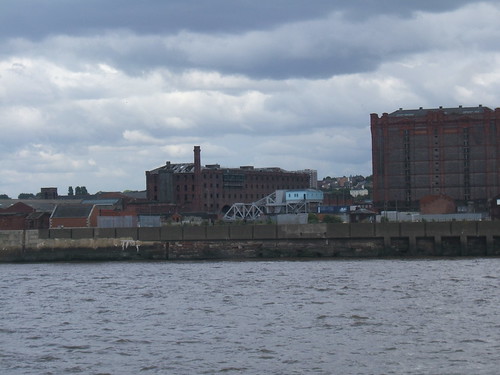 Regent Road Scherzer Rolling Lift Bridge from the river in 2011.
Regent Road Scherzer Rolling Lift Bridge from the river in 2011.
The Scherzer rolling lift bridge is a particular type of Bascule Bridge. You can study the manufacturer's 1906 catalogue extolling the design's virtues here. There are also three Scherzer rolling lift bridges in Birkenhead's docks and I tracked them down on 8th February 2014, as described here.
On 9th August 2014, I explored some of the former Lancashire and Yorkshire Railways in Lancashire and managed to fit in another trip on the Mersey Ferry, which I wrote about here. I took another picture (below) of the Scherzer rolling lift bridge in the Liverpool Docks and thought "I REALLY must have a closer look at that".
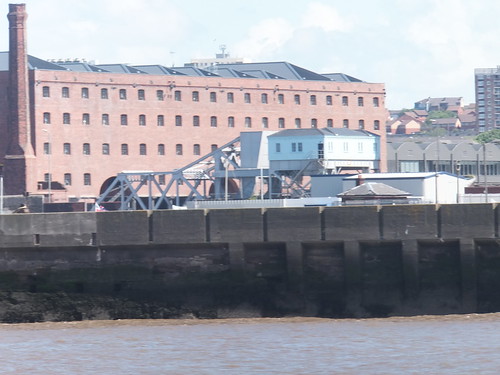 Regent Road Scherzer Rolling Lift Bridge from the river in 2014.
Regent Road Scherzer Rolling Lift Bridge from the river in 2014.
On 4th October 2014, I decided to travel on the railways of the former Cheshire Lines Committee (CLC) which still have a passenger service and those trips are described here. To travel the last few miles of CLC from Hunts Cross to Liverpool Central (the new, underground station - the original surface station has gone), I had to take a Merseyrail Northern Line train and I decided to continue on that train to Sandhills. This part of the day is described in the post More Merseyrail. From Sandhills, I decided to walk back to Pierhead along the dock road (Regent Road) which would take me, at last, across the Regent Road Scherzer Rolling Lift Bridge.
This aerial phograph gives an impression of the Sandhills area in 1937.

Sandhills in 1937: The former Lancashire & Yorkshire Railway line to Southport and Aintree runs horizontally across the middle of the photograph. Nearer the camera (at a lower level) is Huskisson Goods Depot. The road running almost vertically towards the docks is Sandhills Lane. L-R the docks are Sandon (now filled in) and Huskisson Branch Docks 1,2,3 (Click on the image for a slightly larger version).
It's all rather different now, of course.
Sketch Map of part of Liverpool Docks in 2014
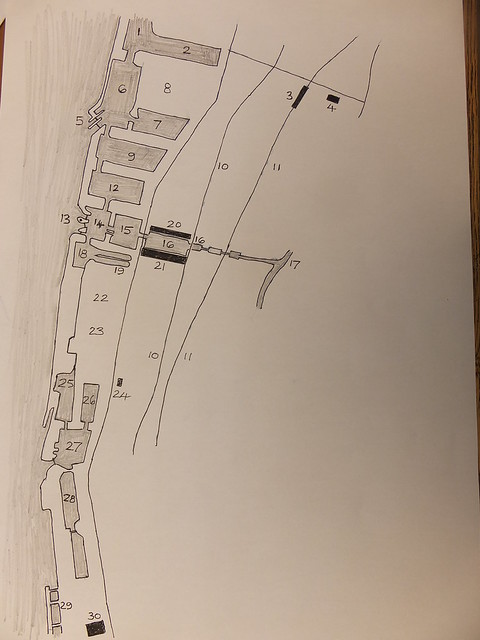 Sketch Map of part of Liverpool Docks in 2014. For explanation of reference numbers, see the table below.
Sketch Map of part of Liverpool Docks in 2014. For explanation of reference numbers, see the table below.
| Ref | Description |
| 1 | Huskisson Dock. |
| 2 | Huskisson Branch Dock No. 1. |
| 3 | Sandhills Station (Merseyrail). |
| 4 | Sandhills Signalling Control Centre (Merseyrail). |
| 5 | Entrance Locks to Sandon Half-Tide Dock. |
| 6 | Sandon Half-Tide Dock. |
| 7 | Wellington Dock. |
| 8 | Former Sandon Dock (now filled-in and United Utilities Liverpool Wastewater Treatment Works). |
| 9 | Bramley-Moore Dock (hydraulic tower on NE quay). |
| 10 | Public Roads. |
| 11 | Merseyrail Northern Line. |
| 12 | Nelson Dock. |
| 13 | Entrance Locks to Salisbury Dock and Victoria Tower. |
| 14 | Salisbury Dock. |
| 15 | Collingwood Dock. |
| 16 | Stanley Dock. |
| 17 | Leeds and Liverpool Canal. |
| 18 | Trafalgar Dock (part filled in). |
| 19 | Clarence Graving Docks. |
| 20 | Former Warehouse now 'Titanic' Hotel. |
| 21 | Tobacco Warehouse. |
| 22 | Former Clarence Dock (now filled-in). |
| 23 | Former Trafalgar and Victoria Docks (now filled-in). |
| 24 | Kingsway Tunnel Ventilation Station. |
| 25 | Waterloo West Dock. |
| 26 | Waterloo East Dock (Grain Dock). |
| 27 | Princes Half-Tide Dock. |
| 28 | Princes Dock. |
| 29 | Liverpool Landing Stage. |
| 30 | Liver Building. |
A walk along Regent Road in 2014
I walked along Sandhills Lane towards the docks until I reached Regent Road and then turned left heading towards Pierhead. Regent Road is divided from the dock estate by a tall boundary wall. In this area, the wall is in Jesse Hartley's 'Cyclopean' masonry. However, at the first set of gates, the gatekeeper's lodge is in brick.
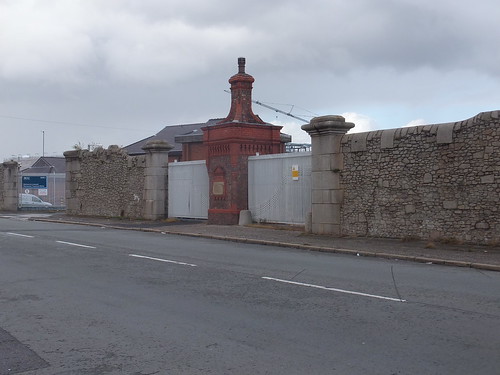 Liverpool Docks, Regent Road: Jesse Hartley's Dock Wall in 'Cyclopean' masonry with In-Out gates flanked by rectangular stone pillars and a brick Gatekeeper's Office in between the two gates provided with a rather fancy roof and central chimney.
Liverpool Docks, Regent Road: Jesse Hartley's Dock Wall in 'Cyclopean' masonry with In-Out gates flanked by rectangular stone pillars and a brick Gatekeeper's Office in between the two gates provided with a rather fancy roof and central chimney.
Sandon Dock has been filled-in and is now home to the huge Liverpool Wastewater Treatment Works, operated by United Utilities. Bramley-Moore Dock and Nelson Dock are still 'wet'. The most notable feature I could see was a derelict brick-built hydraulic tower which appeared to have an integral pump house and chimney, built on the quay at Bramley-Moore Dock. Afterwards, I confirmed that it's a Grade II Listed Engine house, accumulator tower with a pyramidal roof and truncated octagonal chimney (the chimney cap is missing). It's in common brick with red brick dressings, slate roof and round-headed windows/entrances. It was built in 1883 by George Fosbery Lyster (1821 – 1899) who, in 1861, followed Jesse Hartley's son John as Engineer-in-Chief to Mersey Docks and Harbour Board.

Lyster's Hydraulic Tower in Bramley-Moore Dock.
Every so often, the dock wall was pierced by other IN-OUT gateways. A number of them were in the form the form of two gates flanked by round turret-like stone pillars (slotted for sliding gates) with a matching stone Gatekeeper's Office with chimney (or at least the remains of a chimney) in the centre.
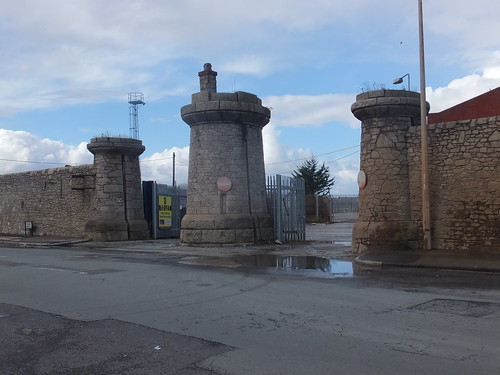 Liverpool Docks, Regent Road: Jesse Hartley Dock Wall with In-Out gates flanked by round turret-like stone pillars (slotted for sliding gates) with matching stone Gatekeeper's Office with chimney in centre.
Liverpool Docks, Regent Road: Jesse Hartley Dock Wall with In-Out gates flanked by round turret-like stone pillars (slotted for sliding gates) with matching stone Gatekeeper's Office with chimney in centre.
In a couple of places, I found a cast iron drinking fountain set in the dock wall. The first was clearly unrestored but the second had been repainted black.

I passed more gates with more variations in design before I approached the Regent Road Scherzer Rolling Lift Bridge. This divides Collingwood Dock from Stanley Dock but neither dock remains in commercial use so the bridge is no longer required to open. The landward end of Stanley Dock connects to the Leeds and Liverpool Canal via locks but canal leisure craft can pass under the bridge when closed.
The northern quay of Stanley Dock has a massive warehouse which re-opened in June 2014 as the Titanic Hotel Liverpool. Reports say 36 million pounds has been spent converting the building into a 4-star 153-room venue. A dispute with contractors held up completion for some weeks until a 5 million pound grant from the City Council was released. Work is continuing on making an Events and Exhibition space as part of the 'Stanley Dock Village Development'. However, the name of the hotel has ruffled feathers at another Liverpool hotel 30 James Street - Home of the Titanic which had its official opening in October 2014.
Next to the bridge is the Stanley Dock Hydraulic Tower - another Jesse Hartley confection looking like a medieval castle next to the associated pumphouse and chimney.
 Liverpool Docks: Regent Road with Jesse Hartley turret style gateposts on left leading to 'Titanic' Hotel, Stanley Dock Hydraulic Tower, pump house and chimney, Rolling Lift Bridge and, in background, Tobacco Warehouse.
Liverpool Docks: Regent Road with Jesse Hartley turret style gateposts on left leading to 'Titanic' Hotel, Stanley Dock Hydraulic Tower, pump house and chimney, Rolling Lift Bridge and, in background, Tobacco Warehouse.
 Stanley Dock Hydraulic Tower, Pumphouse and Chimney with the 'Titanic' Hotel in background.
Stanley Dock Hydraulic Tower, Pumphouse and Chimney with the 'Titanic' Hotel in background.
 View inside the hydraulic tower (Photo: www.urbexforums.com).
View inside the hydraulic tower (Photo: www.urbexforums.com).
The Rolling Lift Bridge has been cosmetically restored. To see what it looked like before restoration, have a look at Urbex Forums here. The bridge was electrically operated and it appears that the gates either side of the bridge which close off the road and the pavements are also power worked. I noticed that a cast electrical terminal box was marked 'IGRANIC'. Igranic originated in 1906 and is now part of Automated Technology Group.
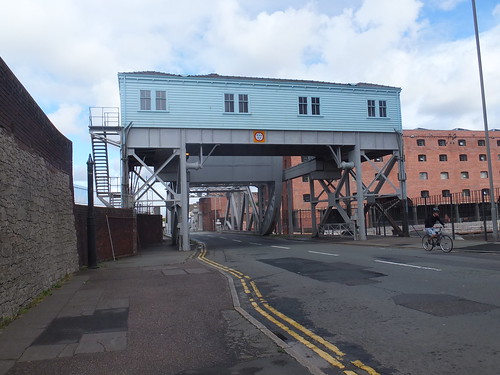 Regent Road Scherzer Rolling Lift Bridge after cosmetic restoration with the 'Titanic' hotel in the background.
Regent Road Scherzer Rolling Lift Bridge after cosmetic restoration with the 'Titanic' hotel in the background.
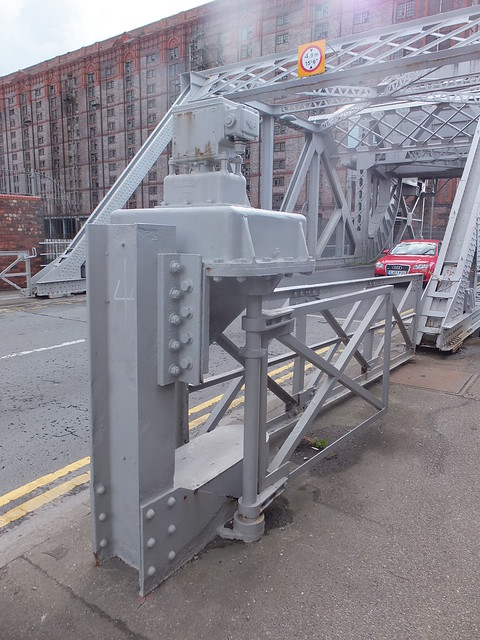 Regent Road Scherzer Rolling Lift Bridge after cosmetic restoration with the Tobacco Warehouse in the background.
Regent Road Scherzer Rolling Lift Bridge after cosmetic restoration with the Tobacco Warehouse in the background.
The 14-storey Stanley Dock Tobacco Warehouse on the south side of Stanley Dock is thought to be the largest brick building in the world (27 million bricks) and was completed in 1901 to a design by A. G. Lyster (mentioned above in connection with the Hydraulic Tower at Bramley-Moore Dock). This huge building awaits restoration.
 The Tobacco Warehouse, Stanley Dock.
The Tobacco Warehouse, Stanley Dock.
I passed the Clarence Graving Docks, out of use and surrounded by a rather bleak area of quayside. Clarence Dock itself was filled-in in 1929 and Clarence Dock Power Station (with its three tall chimneys called affectionately the "three sisters") was built there. In turn, the power station has now gone.
Continuing along Regent Road the tall dock wall is brick with stone cappings and the gateposts are massive rectangular stone pillars, still carrying the names of the docks originally served, like Clarence Dock and Trafalgar Dock. An octagonal modern plaque attached to the wall commemorates the 1.3 million Irish migrants who passed this way during the Great Famine between 1845 and 1852.
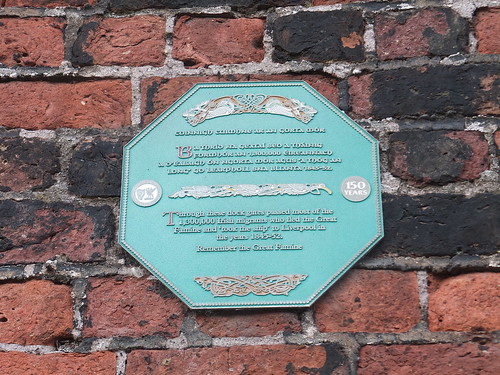 "Through these dock gates passed most of the 1,300,000 Irish migrants who fled the Great Famine and 'took the ship' to Liverpool in the years 1845-52. Remember the Great Famine."
"Through these dock gates passed most of the 1,300,000 Irish migrants who fled the Great Famine and 'took the ship' to Liverpool in the years 1845-52. Remember the Great Famine."
On the left, I passed the ventilating station for the Kingsway Road Tunnel, opened in 1971. The appearance suggests a pair of giant, stereo loudspeakers. Not to my taste, I'm afraid.
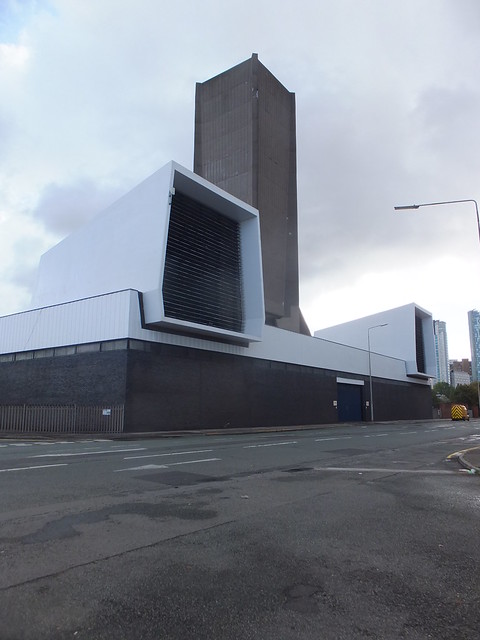 Kingsway Tunnel Ventilating Station.
Kingsway Tunnel Ventilating Station.
Princes Half-Tide Dock, Waterloo West Dock and Waterloo East Dock are still 'wet' but now accessible only to canal craft. The huge warehouse on the east side of Waterloo East Dock has been given a new lease of life as apartments.
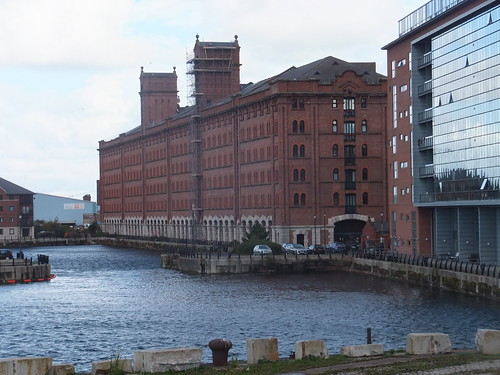 Warehouse on Waterloo East Dock, now apartments.
Warehouse on Waterloo East Dock, now apartments.
The last dock on my walk was Princes Dock, immediately north of the Royal Liver Building. When I was young, Princes Dock had its own railway station, Riverside, served by Boat Trains from London Euston operated in conjunction with Trans-Atlantic liner sailings. Today, you search in vain for signs of this past. Modern buildings line the quays and the dock is only suitable for canal leisure craft.
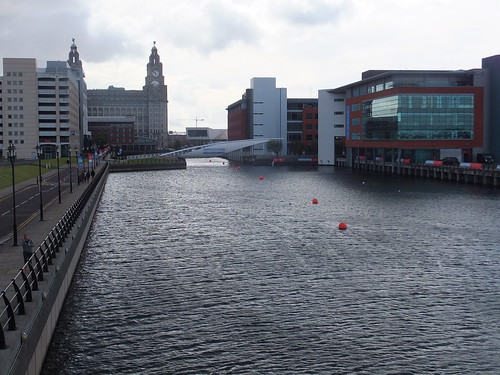 View of Princes Dock looking south, showing the Royal Liver Building and, in the distance, the Museum of Liverpool.
View of Princes Dock looking south, showing the Royal Liver Building and, in the distance, the Museum of Liverpool.
I carried on to Pierhead and, after the usual brief visit to the locomotive 'Lion' in the Museum of Liverpool, walked to James Street Merseyrail station. The next part of my travels is described here.
Related posts on this website
More Merseyrail.
Notes on Liverpool and its Docks..
Books
[1] 'Jesse Hartley - Dock Engineer to the Port of Liverpool 1824-60' by Nancy Ritchie-Noakes, published by National Museums and Galleries on Merseyside (ISBN 0 906367 05 0).
[2] 'L.N.W.R. and the M.D.& H.B. - The History of the Dock Lines from the Records' by J. C. James, Limited Edition published c1981.
[3] 'Prince's Dock - A Magnificent Monument of Mural Art' by Adrian Jarvis published 1991 by Merseyside Port Folios (ISBN 0 9516129 0 5).
[4] 'Liverpool and its Canal' by Mike Clarke and Allison Hewitt published 1992 by Merseyside Port Folios (ISBN 0 9516129 3 X).
[5] 'An Illustrated History of Liverpool's Railways' by Paul Anderson, published Irwell Press (ISBN 1-871608-68-6).
My Pictures
Liverpool Docks.
Liverpool.
